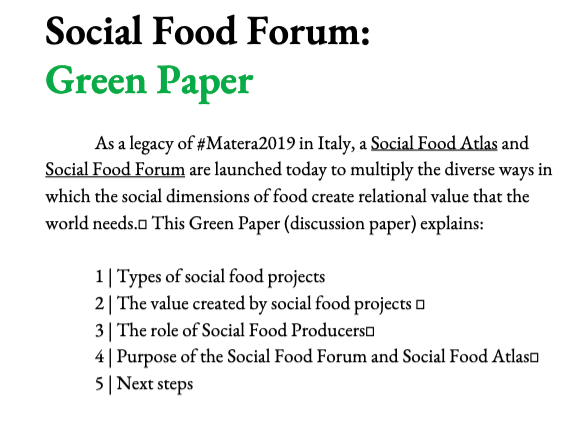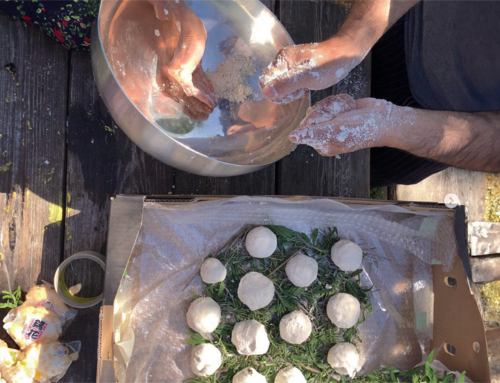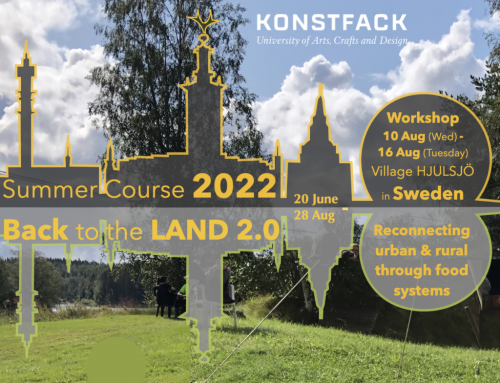Our starting point is that agriculture and food are not just about production and consumption. They are about relationships, too – with each other, with the land, and with living systems.
Green Paper
Our starting point is that agriculture and food are not just about production and consumption. They are about relationships, too – with each other, with the land, and with living systems. The quality of these relationships determines the health of social and ecological systems. These social and ecological relationships, although damaged by modernity, are being re-made by what we are calling social food projects. Such projects are about about care, not just consumption. They are about hospitality and connection – between people, and with place. They are a medium of solidarity among diverse cultures.
As a legacy of #Matera2019 in Italy, a Social Food Atlas and Social Food Forum were launched to multiply the diverse ways in which the social dimensions of food create value that the world needs. – in addition to the calorific and monetary kinds.
https://www.mammamiaaa.it/en/green-paper/
This Green Paper (discussion paper) is principally for those involved in food policy at national, regional and municipal scale. It explains:
1 | Types of social food projects
2 | The value created by social food projects
3 | The role of Social Food Producers
4 | Purpose of the Social Food Forum and Social Food Atlas
5 | Next steps
1 | Types of social food projects
Social food projects enhance relationships in diverse but practical ways: community meals; events; festivals; food hubs that connect growers & citizens; food-waste projects; re-use of buildings & spaces as community kitchens, baking and brewing sites; urban farms; school gardens and edible schoolyards; street food festivals; cooperative grain growing.
By way of illustration, representatives of the following social food projects were invited to Matera to help draft this document: AgriNetural, Matera: maps out disused spaces with the aim of transforming them into urban gardens. Working with local citizens, artists, architects and engineers experiment with different ways to develop agriculture in an urban context.
OpenAgri Milano: promoter of innovative approaches in peri-urban agriculture; educational and training campaigns to revitalise a fringe area of the City of Milan and create new job opportunities;
VaZapp, Italy: curator of the Contadinner dinner series is for young farmers and those that want to get into farming: 20 dinners, 20 farmhouses, 20 young farmers each dinner.
Germinando, Madrid: training, research, awareness-raising and technical support in participatory urban and food system planning. MARES Alimentación,, also in Madrid, a food hub fostering social economy projects in the food sector – cooperative supermarkets, community kitchen, or self-managed logistic centres.
SIMRA: European network of social innovation projects in marginalised rural areas, with a focus on the Mediterranean region;
Sustainable Food Lab, Sweden: Gothenburg’s most sustainable event space hosts a lab for the creation of meals from food ‘waste’ ;
Urbaniahoeve, Amsterdam: a lab for food and ecological systems in public space; its projects include a a 45 HA urban food forest implemented by two different communities;
Doors of Perception xskool: place-based workshops that combine social farming, place-based development, and active learning;
Holis, Poland-Hungary: summer schools that explore a timely question in an important location: “what are the challenges of rural Poland and what can we do about them?”
Atelier Luma, Arles, France: citizens from diverse cultures develop a range of ideas around food waste, food cycles, local gardening, food accessibility, and shared kitchens.
Burren Wintrage Fesitval; Ireland: farmers, researchers, farm advisors and government representatives share perspectives and ideas on sustainable pastoral land management.
High Nature Farming Link: EU network that develops and shares collaborative innovation in support of farming systems in areas of exceptional natural values.
2 | The value created by social food projects
Our starting point is that agriculture and food are not just about production and consumption. They are about relationships, too – with each other, with the land, and with living systems. The quality of these relationships determines the health of social and ecological systems. These social and ecological relationships, although damaged by modernity, are being re-made by what we are calling social food projects. Such projects are about about care, not just consumption. They are about hospitality and connection – between people, and with place. They are a medium of solidarity among diverse cultures.
Public Policy
In the language of public policy, social food projects create public goods in the form of social cohesion, public health, territorial development, food sovereignty, learning, innovation, and biodiversity. Social food projects enable citizens to participate in activities, at a local level, that increase their health and wellbeing.
Social food is central to many ‘smart village’ and ‘smart neighbourhood’ projects (relationships among social networks are enhanced by digital telecommunications).
Social food projects are a gateway for citizen support and participation in environmental restoration actions that increase biodiversity.
The key to the future of food also lies in its history. Social food projects revive cultural and natural heritage, and remake the social fabric and character of Europe’s landscapes.
Social food projects create relationships between actors who can find it hard to work together: farmers; farmer organisations; researchers; national regional and local authorities; policy makers; agricultural extension and innovation services; tourism operators; students and researchers; civil society.
Communities
Social food projects are a medium of public dialogue that bring together a diverse group of citizens who are concerned about the future of their community.
Social food projects are a medium of hospitality among local citizens of diverse cultures.
Gardens (and kitchens) in schools and colleges are sites of social learning.
The exchange of ideas among social food projects enhances a community’s capacity for innovation.
Farmers and food producers
Social food projects reduce the social isolation experienced by many farmers; this enhances their lives and, in consequence, the resilience of a region’s food systems.
The direct participation of citizens in farm-based activities can diversify income for farmers.
Local and regional government
Connecting the cultural meanings of food and agriculture, to stories of person, and place, adds value to tourism in a region.
Social food projects can be catalytic in the relocalisation of food and fibre systems
Social food projects are central to the emergence of new rural economies; they enable new urban-rural business partnerships Social food projects can involve socially-excluded people in on-farm activities. – refugees, elderly people, or people with dementia.
Measuring the value of social food projects
In order for government agencies and other funders to provide financial support to social food projects, they usually require numbers to measure the value created. Here are some examples of how such value can be measured:
Growing Health A study by Garden Organic and Sustain, in England, demonstrates the strength of evidence for the benefits of of community food-growing projects for physical and mental health and wellbeing.
Kilowatt Social Impact Analysis ForKilowatt, urban regeneration means social cohesion, trust and relationship building between the public, the private, the third sector and civic society. Transparency and accountability are needed to continue on this path, so Kilowatt publish annual Social Reportthat reflect on results achieved, lessons learned, and impact created.
True Value: CommunityFarms and Gardens Research carried out by Federation of City Farms and Community Gardens, also in the UK, assessed the impact and value of community farms and gardens.Outcomes measured included opportunities for engagement, volunteering, training, capacity building and empowerment.
Food for Life Initiative : Social Return on Investment In Scotland, East Ayrshire Council’s Food for Life Initiative provides healthy school meals to primary pupils. Social, environmental and health benefits, and resulting financial values, were calculated using the SROI methodology.
Local Food Programme: Social Return on Investment. In Gloucester, England, knowledge of food growing was shown to improve diet and physical health over the longer term. Reduced social isolation through volunteering was shown to lead to an increased sense of belonging and improved resilience and self esteem.
Wellbeing and Resilience Measure (WARM) In England, the WARM method “takes the temperature of local communities”. WARM combines existing data about localities, such as jobs and health, with new ways of thinking about how the resilience of communities.
3 | Social Food Producers
Social food projects do not organise themselves. They happen thanks to the work of Social Food Producers and Curators.
These individuals identify opportunities in communities, and explore how neglected assets – projects, places, or individuals – can be connected in events and enterprises.
Social food producers are expert in designing the conditions for successful collaboration; they enable a wide variety of stakeholders to collaborate. Among their most valuable skills are hosting, convening, facilitating, animating, and co-ordinating. Many social food producers work independently. They can be geographically scattered and socially disconnected – even from each other. Their work is not well understood by public authorities and policy makers. As a result – despite the valuable public goods their work creates – they are economically precarious.
4 | Social Food Forum: Next Steps
Social food projects create value that the world needs. The Social Food Forum was launched to help Social Food Producers do more of this work, in new places, and with new partners, after Matera2019 is over.
The worlds of food, farming, and agriculture contain many thousands of networks, platforms, professional associations, industry organisations, advocacy groups, and international bodies.It’s not obvious that the world needs another one of those. Some people we have spoken to complain of “networking fatigue”.
At their inaugural meeting March 2019, a working group of 15 social food producers explored four ways to achieve this objective:
a) Raise awareness about the value created by social food projects in the form of public goods. This work has started with Mammamiaaa , a project of #Matera2019, in which thousands of dinners across Italy and Europe are being organised to celebrate the role of women in creating meals. The ways in which grandmothers, mothers, fathers, uncles, and children, prepare, cook, and eat, together, are being be collected, and shared. https://www.mammamiaaa.it/en/archive/
b) Make social food projects visible: the wide variety of social food projects already under way. The Social Food Forum has launchedanonlineS ocialFoodAtlas thatmakesvisible–and findable – a wide variety of social food projects that, right now, are little known – even to each other.
c) Develop new concepts, projects and partnerships: The Forum will foster relationships with each other, with citizens, with public officials, and with economic actors. A number of European networks already share knowledge and best practices about topics that intersect with social food projects. Rather than duplicate these efforts, the Social Food Forum has already made contact with European networks such as SIMRA (Social Innovation In Marginalised Rural Areas); HNV Link (High Nature Value Farming learning areas) where culture complements nature”
d) Share knowledge and develop skills: There is scope to: expand the Atlas as an online archive; identify learning sites in cities and regions; organise cross visits between learning sites; commission evidence-based recommendations for policy makers and local authorities; deliver social food courses; share knowledge in the form of case studies and best practices both online, and in live encounters.
Your Content Goes Here




